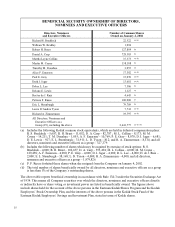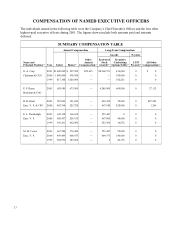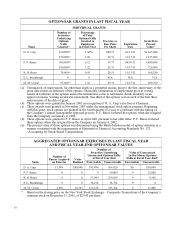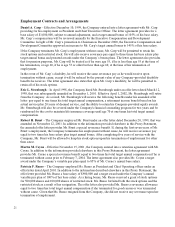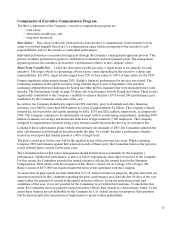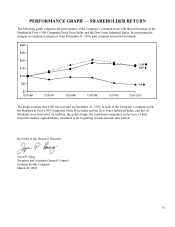Kodak 2001 Annual Report Download - page 111
Download and view the complete annual report
Please find page 111 of the 2001 Kodak annual report below. You can navigate through the pages in the report by either clicking on the pages listed below, or by using the keyword search tool below to find specific information within the annual report.
The following table shows the years of service credited as of December 31, 2001, to each of the named
executive officers. This table also shows the amount of each named executive officer’s APC at the end of 2001,
except for Mr. Brust and Ms. Russo, who participated in the cash balance feature in 2001.
RETIREMENT PLAN
Name Years of Service Average Participating Compensation
D. A. Carp 31 $1,658,367
E. L. Steenburgh 3(a) 863,086
M. M. Coyne 19(b) 807,008
(a) Upon Mr. Steenburgh’s retirement on April 1, 2002, he will be credited with 20 extra years of service for
purposes of calculating his retirement benefit.
(b) If Mr. Coyne remains employed until February 7, 2004, he will be credited with eight extra years of
service for purposes of calculating his retirement benefit.
Cash Balance Feature
Under the cash balance feature of the Company’s pension plan, the Company establishes an account for each
participating employee. Every month the employee works, the Company credits the employee’s account with
an amount equal to four percent of the employee’s monthly pay. In addition, the ongoing balance of the
employee’s account earns interest at the 30-year Treasury bond rate. To the extent federal laws place
limitations on the amount of pay that may be taken into account under the plan, four percent of the excess pay
is credited to an account established for the employee in an unfunded supplementary plan. If a participating
employee leaves the Company and is vested (five or more years of service), the employee’s account balance
will be distributed to the employee in the form of a lump sum or monthly annuity. If the participating
employee’s account balance exceeds $5,000, the employee also has the choice of leaving his or her account
balance in the plan to continue to earn interest.
In addition to the benefits described above, Mr. Brust is covered under a special supplemental pension
arrangement established under his amended offer letter. This arrangement provides Mr. Brust a single life
annuity of $12,500 per month upon his retirement if he remains employed with the Company for at least five
years. If Mr. Brust remains employed until January 3, 2007, he will, in lieu of receiving the $12,500 per month
annuity, be treated as if eligible for the non-cash balance portion of the plan. For this purpose, Mr. Brust will be
credited with 18 years of extra service in addition to his actual service. In either case, Mr. Brust’s supplemental
benefit will be offset by his cash balance benefit.
Ms. Russo’s April 1, 2001 offer letter provided her a supplemental pension benefit that treated her as if she
were eligible for the non-cash balance portion of the plan with 20 years of extra service. Since Ms. Russo did
not remain employed for five years, she forfeited this benefit upon her resignation from the Company.
24



